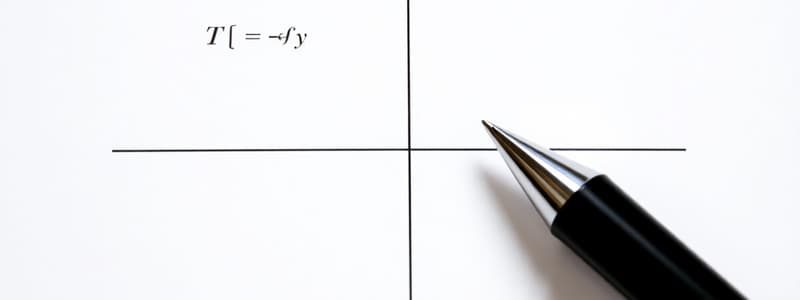Podcast
Questions and Answers
Matt views conditioner (C) and shampoo (S) as perfect complements, using one squirt of conditioner for each squirt of shampoo. If shampoo costs $1 per squirt and conditioner costs $2 per squirt, and Matt has $9 to spend, how many squirts of each will he buy?
Matt views conditioner (C) and shampoo (S) as perfect complements, using one squirt of conditioner for each squirt of shampoo. If shampoo costs $1 per squirt and conditioner costs $2 per squirt, and Matt has $9 to spend, how many squirts of each will he buy?
Matt will buy 3 squirts of shampoo and 3 squirts of conditioner.
Geronimo's demand curve for apples is given by $a = \frac{p_bM}{p_a(p_a + p_b)}$, where $p_a$ is the price of apples, $p_b$ is the price of bananas, and $M$ is his income. Based on this information, are apples and bananas substitutes or complements? Explain.
Geronimo's demand curve for apples is given by $a = \frac{p_bM}{p_a(p_a + p_b)}$, where $p_a$ is the price of apples, $p_b$ is the price of bananas, and $M$ is his income. Based on this information, are apples and bananas substitutes or complements? Explain.
Apples and bananas are substitutes. As the price of bananas ($p_b$) increases, the quantity of apples demanded (a) increases, indicating a substitution effect.
Andre's demand for doughnuts is given by $Q = 5 - p$, Baby's by $Q = 6 - 2p$, and Cooper's by $Q = 4 - \frac{p}{2}$. Derive the market demand for doughnuts, taking into account the maximum price each consumer will pay.
Andre's demand for doughnuts is given by $Q = 5 - p$, Baby's by $Q = 6 - 2p$, and Cooper's by $Q = 4 - \frac{p}{2}$. Derive the market demand for doughnuts, taking into account the maximum price each consumer will pay.
The market demand is Q = 15 - (7/2)p for $0 ≤ p ≤ 8$, Q = 11 - (5/2)p for $8 < p ≤ 10$, and Q = 5 - p for $10 < p ≤ 5.
Miquel and Jake's paper company uses the production function $Q = K^{1/2}L^{1/2}$ to produce reams of paper. They need to produce 10 reams of paper each week. If the price of capital (K) is $1 per unit and the price of labor (L) is also $1 per unit, how many units of each input should they use to minimize the cost of producing the 10 reams of paper? Explain.
Miquel and Jake's paper company uses the production function $Q = K^{1/2}L^{1/2}$ to produce reams of paper. They need to produce 10 reams of paper each week. If the price of capital (K) is $1 per unit and the price of labor (L) is also $1 per unit, how many units of each input should they use to minimize the cost of producing the 10 reams of paper? Explain.
A firm's total cost is given by $C(Q) = 15Q^2 + 8Q + 45$, where Q is the quantity of output. Find the average cost (AC) as a function of quantity.
A firm's total cost is given by $C(Q) = 15Q^2 + 8Q + 45$, where Q is the quantity of output. Find the average cost (AC) as a function of quantity.
A firm's total cost is given by $C(Q) = 15Q^2 + 8Q + 45$ where Q denotes the quantity of output. Find the marginal cost (MC) as a function of quantity.
A firm's total cost is given by $C(Q) = 15Q^2 + 8Q + 45$ where Q denotes the quantity of output. Find the marginal cost (MC) as a function of quantity.
A firm's total cost is $C(Q) = 15Q^2 + 8Q + 45$. For what quantities is the average cost greater than the marginal cost? Explain.
A firm's total cost is $C(Q) = 15Q^2 + 8Q + 45$. For what quantities is the average cost greater than the marginal cost? Explain.
A firm's total cost is given by $C(Q) = 15Q^2 + 8Q + 45$ where Q denotes the quantity of output. Find the average variable cost (AVC) as a function of quantity.
A firm's total cost is given by $C(Q) = 15Q^2 + 8Q + 45$ where Q denotes the quantity of output. Find the average variable cost (AVC) as a function of quantity.
Cardboard boxes are produced in a competitive market. A firm in this market has the cost function $C(q) = 3q^3 - 18q^2 + 40q + 50$, where q denotes the quantity of output. Find the fixed cost and the variable cost functions.
Cardboard boxes are produced in a competitive market. A firm in this market has the cost function $C(q) = 3q^3 - 18q^2 + 40q + 50$, where q denotes the quantity of output. Find the fixed cost and the variable cost functions.
A firm's cost function is $C(q) = 3q^3 - 18q^2 + 40q + 50$. Find the marginal cost function.
A firm's cost function is $C(q) = 3q^3 - 18q^2 + 40q + 50$. Find the marginal cost function.
A firm's cost function is given by $C(q) = 3q^3 - 18q^2 + 40q + 50$. For what prices will the profit-maximizing output be greater than zero? Explain.
A firm's cost function is given by $C(q) = 3q^3 - 18q^2 + 40q + 50$. For what prices will the profit-maximizing output be greater than zero? Explain.
Mariah consumes music downloads (x) and concert tickets (y). Her utility function is given by $U(x,y) = x^2 + 2y$. Find the equation for her indifference curve with $y$ as a function of $x$ when utility is equal to $U = 2$.
Mariah consumes music downloads (x) and concert tickets (y). Her utility function is given by $U(x,y) = x^2 + 2y$. Find the equation for her indifference curve with $y$ as a function of $x$ when utility is equal to $U = 2$.
Mariah consumes music downloads (x) and concert tickets (y). Her utility function is given by $U(x,y) = x^2 + 2y$. Using the indifference curve from part (a) of the original question, is the marginal rate of substitution (MRS) diminishing as x increases?
Mariah consumes music downloads (x) and concert tickets (y). Her utility function is given by $U(x,y) = x^2 + 2y$. Using the indifference curve from part (a) of the original question, is the marginal rate of substitution (MRS) diminishing as x increases?
Mariah consumes music downloads (x) and concert tickets (y). Her utility function is given by $U(x,y) = x^2 + 2y$. Do Mariah's preferences satisfy 'more is better'? Explain.
Mariah consumes music downloads (x) and concert tickets (y). Her utility function is given by $U(x,y) = x^2 + 2y$. Do Mariah's preferences satisfy 'more is better'? Explain.
Mariah consumes music downloads (x) and concert tickets (y). Her utility function is given by $U(x,y) = x^2 + 2y$. What consumption bundle(s) are optimal when each good costs $1 per unit and Mariah's total income is $10?
Mariah consumes music downloads (x) and concert tickets (y). Her utility function is given by $U(x,y) = x^2 + 2y$. What consumption bundle(s) are optimal when each good costs $1 per unit and Mariah's total income is $10?
Matt considers conditioner (C) and shampoo (S) as perfect complements and wants to consume one squirt of conditioner for each squirt of shampoo. Draw an indifference curve for (C, S) = (1,2). Be sure to label the axes and the point (1,2) on the indifference curve.
Matt considers conditioner (C) and shampoo (S) as perfect complements and wants to consume one squirt of conditioner for each squirt of shampoo. Draw an indifference curve for (C, S) = (1,2). Be sure to label the axes and the point (1,2) on the indifference curve.
Geronimo has the demand curve for apples given by $a = \frac{p_bM}{p_a(p_a + p_b)}$, where $p_a$ is the price of apples, $p_b$ is the price of bananas, and $M$ is Geronimo's income. Based on this information, is an apple a normal or inferior good? Explain why.
Geronimo has the demand curve for apples given by $a = \frac{p_bM}{p_a(p_a + p_b)}$, where $p_a$ is the price of apples, $p_b$ is the price of bananas, and $M$ is Geronimo's income. Based on this information, is an apple a normal or inferior good? Explain why.
Miquel and Jake run a paper company. Each week they need to produce 10 reams of paper. The production function for paper is given by $Q = K^{\frac{1}{2}}L^{\frac{1}{2}}$ where $Q$ is the number of reams of paper produced and $K$ and $L$ denote the number of inputs of capital and employed workers, respectively. Given these input prices, and the current production level $Q = 10$, what is the marginal cost of paper? Explain.
Miquel and Jake run a paper company. Each week they need to produce 10 reams of paper. The production function for paper is given by $Q = K^{\frac{1}{2}}L^{\frac{1}{2}}$ where $Q$ is the number of reams of paper produced and $K$ and $L$ denote the number of inputs of capital and employed workers, respectively. Given these input prices, and the current production level $Q = 10$, what is the marginal cost of paper? Explain.
Miquel and Jake run a paper company. Each week they need to produce 10 reams of paper. The production function for paper is given by $Q = K^{\frac{1}{2}}L^{\frac{1}{2}}$ where $Q$ is the number of reams of paper produced and $K$ and $L$ denote the number of inputs of capital and employed workers, respectively. What is the average cost of paper at this level of production? Explain.
Miquel and Jake run a paper company. Each week they need to produce 10 reams of paper. The production function for paper is given by $Q = K^{\frac{1}{2}}L^{\frac{1}{2}}$ where $Q$ is the number of reams of paper produced and $K$ and $L$ denote the number of inputs of capital and employed workers, respectively. What is the average cost of paper at this level of production? Explain.
Flashcards
Perfect Complements
Perfect Complements
Goods consumed together, like Matt's shampoo and conditioner, used in a fixed ratio.
Indifference Curve
Indifference Curve
A curve showing combinations of goods that give the consumer the same level of satisfaction.
Normal Good
Normal Good
A good for which demand increases as income increases.
Substitutes
Substitutes
Signup and view all the flashcards
Market Demand
Market Demand
Signup and view all the flashcards
Marginal Rate of Technical Substitution
Marginal Rate of Technical Substitution
Signup and view all the flashcards
Marginal Cost
Marginal Cost
Signup and view all the flashcards
Average Cost
Average Cost
Signup and view all the flashcards
Fixed Costs
Fixed Costs
Signup and view all the flashcards
Variable Costs
Variable Costs
Signup and view all the flashcards
Marginal Utility
Marginal Utility
Signup and view all the flashcards
Indifference Curve
Indifference Curve
Signup and view all the flashcards
Marginal Rate of Substitution (MRS)
Marginal Rate of Substitution (MRS)
Signup and view all the flashcards
Study Notes
- This exam is for ECON2011 Principles of Microeconomics students at the St Lucia Campus.
- The exam duration is 90 minutes, with a reading time of 10 minutes.
- This is a School Examination and a Closed Book Examination.
- Writing is only permitted on rough paper during reading time.
- The examination paper will not be released to the Library.
- No electronic aids are permitted (e.g., laptops, phones).
- An unmarked Bilingual dictionary is permitted.
- Calculators allowed are Casio FX82 series or UQ approved (labelled).
- Students get a 1 x 14 Page Answer Booklet.
- Answer all questions in your Answer Booklet(s).
- Additional answer booklets and rough paper are provided upon request.
- Total questions: 7
- Total marks: 35
Question 1: Matt's Preferences for Conditioner and Shampoo
- Matt views conditioner (C) and shampoo (S) as perfect complements and likes one squirt of conditioner for each shampoo squirt.
- Part (a) requires drawing the indifference curve for (C, S) = (1,2), including labeled axes and the point (1,2).
- Part (b) involves determining how many squirts of each Matt will buy with $9, given shampoo costs $1 per squirt and conditioner costs $2 per squirt.
Question 2: Geronimo's Demand for Apples
- Geronimo’s demand curve for apples is given by 𝑎 = (𝑝𝑏𝑀) / (𝑝𝑎(𝑝𝑎 + 𝑝𝑏)), where pa > 0 and pb > 0 are the prices of apples and bananas, respectively, and M > 0 is Geronimo’s income.
- Part (a) asks whether apples are a normal or inferior good based on the demand curve information.
- Part (b) asks whether apples and bananas are substitutes or complements based on the demand curve information.
Question 3: Market Demand for Doughnuts
- Andre’s demand for doughnuts is given by Q = 5 – p, Baby’s by Q = 6 – 2p, and Cooper’s by Q = 4 - p/2.
- Part (a) requires deriving the market demand for doughnuts, considering the maximum price each consumer will pay.
- Part (b) requires drawing the market demand curve.
Question 4: Miquel and Jake's Paper Company
- Miquel and Jake need to produce 10 reams of paper weekly with the production function Q = K^(1/4) * L^(1/4), where Q is reams of paper, K is capital, and L is labor.
- The price of K is $1 per unit, and the price of L is also $1 per unit.
- Part (a) asks for the units of each input that minimize the cost of producing 10 reams of paper.
- Part (b) asks for the marginal cost of paper, given the input prices and a production level of Q = 10.
- Part (c) asks for the average cost of paper at the same production level.
Question 5: Firm's Total Cost and Output
- A firm's total cost is given by C(Q) = 15Q² + 8Q + 45, where Q is the quantity of output.
- Part (a) asks to find the average cost as a function of quantity.
- Part (b) asks to find the marginal cost as a function of quantity.
- Part (c) asks at what quantities the average cost is greater than the marginal cost.
- Part (d) asks to find the average variable cost as a function of quantity.
Question 6: Cardboard Boxes in a Competitive Market
- A firm in a competitive market produces cardboard boxes with a cost function C(q) = 3q³ – 18q² + 40q + 50, where q is the quantity of output.
- Part (a) asks to find fixed cost and variable cost functions.
- Part (b) asks to find the marginal cost function.
- Part (c) asks at what prices the profit-maximizing output will be greater than zero.
Question 7: Mariah's Consumption of Music Downloads and Concert Tickets
- Mariah's utility function for music downloads (x) and concert tickets (y) is U(x,y) = x² + 2y.
- Part (a) asks for the equation for Mariah's indifference curve with y as a function of x when utility U = 2.
- Part (b) asks to use the indifference curve from part (a) to determine if the indifference curve is becoming flatter (diminishing MRS) as x increases.
- Part (c) asks, do Mariah’s preferences satisfy more is better?
- Part (d) asks what consumption bundles are optimal when each good costs $1 per unit, and Mariah's total income is $10.
Studying That Suits You
Use AI to generate personalized quizzes and flashcards to suit your learning preferences.




